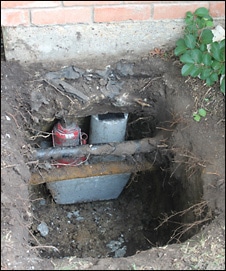 “Pressed Pilings” are one of the most used common techniques for concrete foundation repair in Houston, Texas. The steel-threaded concrete piling and its installation method was specifically designed for the clay soils found here and in various areas throughout Texas. Take a look below to find out more.
“Pressed Pilings” are one of the most used common techniques for concrete foundation repair in Houston, Texas. The steel-threaded concrete piling and its installation method was specifically designed for the clay soils found here and in various areas throughout Texas. Take a look below to find out more.
How Long Would It Take To Repair?
The average concrete foundation repair project in Houston can be finished in one or two work-days. The installation is quick and efficient. This also helps to give any plants that have been removed a good chance of survival.
How Do You Install The Piers?
We will start by digging a hole with a shovel. This is normally around two-foot in size and it will be four to five feet below ground level. This hole will also extend under the beam of the home so it can be lifted with safety in mind.
We will then take a concrete cylinder that is 6 x 12 inches. This will have a ¾ inch hole and it will be placed directly underneath the grade beam. After this has been done, we will then take a hydraulic ram, establishing it between the cylinder and the initial beam.
Once the ram has been engaged, the concrete will be pushed into the ground. Every cylinder that we use will also be connected with a steel rebar but eventually they will be pushed until they can’t go down anymore. This is because it would take more force to push the piling than it would to lift the entire house, and when we are at this stage, we can then begin to install the required pilings.
Capped With Concrete
Of course, every piling that is installed has a concrete cap. After this stage has been completed, we will then lift the house by using a bottle jack. We will always make sure that the house is lifted to its original position, and this is done to try and stop any irreparable damage to the home or the structure.
Two cylinders are then set on the cap and steel shims are used to fill the gaps between the piling and the beam. Any holes that are present are then filled to ensure a top result every single time.

Do You Offer A Warranty?
We offer a transferable Lifetime Warranty on pilings that we install. We want to make sure that your home is permanently stabilized on the foundation and we pride ourselves on the quality service that we offer to our customers.
Steel Pressed Pilings
 Concrete Foundation Repair with Steel Pressed Pilings
Concrete Foundation Repair with Steel Pressed Pilings
Steel Pressed Pilings
Steel pilings can be used in place of concrete pressed pilings and in some instances they may even offer a better solution. This is especially the case where the soil is notably sandy or where there are harder sections of strata between the layers of clay. If concrete piling is used in this instance then they may cause what is called a “false refusal point”. Steel on the other hand can penetrate through this without any notable difficulty.
How Long Will It Take To Make The Repair with Steel Pilings?
The same concept applies with concrete pilings; the average foundation repair can be done in one or two work-days.
How Do You Install The Pilings?
The installation process is exactly the same as the concrete piling installation, but instead of using a concrete cylinder, we will press one foot sections of steel pipe. These steel pipe sections are double walled for extra stability.
Warranty
We offer a Transferable Lifetime Warranty to every single person who hires our pressed piling services and we aim to stabilize every portion of the foundation where piers may be installed.
-0-
Concrete Foundation Repair Terms
Builders Piers
Piers are normally poured before you lay the foundation. They are spaced around 4 feet apart and they are very shallow when compared to other structures. The piers are made to help hold the beam into place but due to low placement, it’s not uncommon for them to fail in this. For this reason, you may need to put more pressed pilings in place to stop any unwanted movement from occurring. In some instances the piers may be attached onto the foundation, and if this is the case then they might need to be removed.
Drilled Piers
Drilled piers have a concrete section that is put into place. This can be done in Situ or a steel casing, and you may have either a straight shaft or a bell bottom
Footing
A footing is the support base that is usually done for a wall. It can also be a reference to a shallow pier.
Differential Settlement
This term is used to describe a problem where one part of the building has moved at a different level when compared to the other foundation or walls.
Interior Pier
This is when the foundation might have settled more than usual and the elevation in the property needs to be raised in order to install the piers. The piers are normally placed underneath an interior beam however this depends on the original condition. They can be placed in a steel angle iron under the slab and once this has been done, you can replace the floor that covers this with ease.
Mudjacking
Mudjacking is where you pump water, cement and dirt under the concrete slabs to fill in the gap as a result of the lift. The mixture is often referred to as being a slurry and the exact ingredients used can vary depending on the company and the job. You may also call it pressure grouting, but it is important to make sure the plumbing has been fully tested before you mudjack anything or else the slurry may go into the plumbing.
Concrete Piling
The piling method is when you use concrete cylinders to push into the soil. Eventually the piles get to a point when they can’t be pushed down any more, so they lift the building enough for us to get the hydraulic jack underneath instead.
Post Tension Slab
Post tension constructions help to create a grid of cables and these help to support the slabs. Unlike inactive rebar constructions, this method also helps cover the cables, ensuring that they are protected from any corrosion.
Spread Footing
A wide and shallow footing is made up from reinforced concrete. They have a very high rate of failure as a piering system because of how shallow they are.
Steel Pilings
This pressed method uses a variety of interlocking parts that are pushed into the soil. They will then get to a point when they cannot be driven any more, and this is called a refusal point. Once this has been done, the next step can then commence.
Upheaval
This occurs when the foundation is moved upwards because the clay soils have swelled because of increased moisture content. Upheaval can lead to plumbing leaks and poor drainage. Upward movement after this point can distort the foundation and create various cracks in the finishes, which is something that you want to avoid at all costs.
Structured Foundation Repairs Houston is a proud member
of the National Foundation Repair Association.






